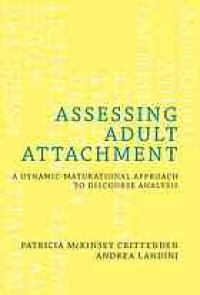"This book brings together a wealth of research, clinical and training experience, offering more than just a new approach to the analysis of adult attachment texts. It will be of great value for researchers, clinicians, and trainers."--Rudi Dallos, Department of Clinical Psychology, University of Plymouth.
Crittenden and Landini describe a method for identifying the psychological and interpersonal self-protective attachment strategies of adults by applying discourse analysis to semi-structured interviews. This method was developed in a multi-cultural context with special attention to the needs and characteristics of vulnerable and troubled adults, i.e., those exposed to the threats of low income, limited education, family conflict, and physical and psychological trauma. Based on Bowlby's notion of comparing individuals' multiple verbal representations (Bowlby, 1980), the method systematically probes different memory systems (Schacter & Tulving, 1994) to elicit representations of the relation of self to context.
The method is ideally attuned to The Adult Attachment Interview (AAI, George, Kaplan, & Main, 1984, 1985, 1996), but other interviews, e.g., The Parents Interview (Crittenden, 1981) that probe memory systems systematically are equally amenable to analysis.
The method employs the Dynamic-Maturational Model of Attachment and Adaptation (DMM). Central ideas are (1) the importance of exposure to danger in shaping mental and behavioral functioning, (2) the organized self-protective function of behavior that others have found inexplicable and unclassifiable, (3) representation of these functions in the preconscious construction of language, and (4) the dynamic and interactive quality of representation.
Ainsworth's ABC patterns of infant attachment are the starting point from which the authors blaze a life-span view of adaptation that is both intuitively simple in structure and also complexly nuanced in execution. The DMM transforms attachment theory from a truth stuck in the late twentieth century to a process for posing questions suited to current science and a theory poised to accommodate future discoveries.
DMM discourse analysis encompasses ideas as revolutionary as neurolinguistics once was and as fresh as the current revolution in the cognitive neurosciences. The method permits users to draw new and richer meanings from existing assessment tools, including reanalyzing existing AAI protocols. The outcome can change our understanding of interpersonal difficulty, psychiatric disorder, and criminal behavior.
Whether used as a guide to treatment formulation or a basis for gathering empirical data, the book is a must for clinicians and researchers alike. --Book Jacket.

